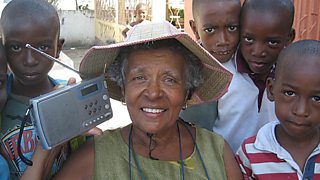People helping people: simple communication technology saves lives
James Deane
Director, Policy and Learning
Tagged with:

Through Connexion Haiti, Βι¶ΉΤΌΕΔ World Service provided daily broadcasts in the aftermath of the 2010 earthquake. Produced and edited by a team based in Miami, the programmes shared vital information.
When the Haitian capital of Port au Prince was devastated by an earthquake in January 2010, the studio and internet connections of Haiti's Radio 1 were among the only fragments of infrastructure to survive in the city. And when popular DJ Carel Pedre went back on air and online before the dust had settled, he was inundated with calls, visits and social media messages from survivors and worried friends and relatives.
Every day for weeks, he and a team of friends compiled lists of missing people for the station's courier, who went out on his motorbike to search for them. They uploaded the information to Facebook, relayed it on Twitter and broadcast it on air, developing an organic, effective emergency response system that reunited families and saved lives.
None of this was carried out with support from the international aid community, but was an example of people in crisis helping each other.
This story is just one of many that Βι¶ΉΤΌΕΔ Media Action gathered for its recent policy briefing Still Left In The Dark? Authored by Imogen Wall, Still Left In The Dark? brings into focus an extraordinary shift in how people access and communicate information in those regions most vulnerable to humanitarian disasters, and how the international donor community is failing to keep up.
As access to technology has boomed across the developing world, even those with very limited resources are spending high proportions of their income (17% on average compared with 1.5% in the developed world) on information communication technology.
As DJ Pedre's story shows, communication technology can then be harnessed to connect people who need and can give help quickly and efficiently. Mobile phones in particular have proven in recent years to be a life-saver during emergencies, with trapped victims using mobiles to guide rescuers to them and disaster affected communities issuing instant warnings to those further afield.
And yet, as Still Left In The Dark? finds, this communication revolution in disaster response on the ground is not being mirrored within the emergency assistance community.
World Humanitarian Day, on 19 August, represents an opportunity to remind humanitarian agencies of the steps that they can and should take to support and complement local communication capabilities and networks when a region is in crisis.
First, agencies and aid workers must start conceptualising communication as an integral part of their programming, recruiting communication specialists who can facilitate meaningful interaction between agency and 'beneficiary', rather than simple message delivery. Such staff can help tailor responses to the specific communication capabilities of communities in crisis, adopting a context-led, multi-channel approach, as did DJ Pedre and his team in Haiti.
Second, humanitarian agencies must further consult with local communication experts such as journalists and IT specialists, as well as with the private sector, which can provide technological expertise and services that many aid agencies cannot.
Third, agencies must also get better at listening. Feedback and a two-way conversation are crucial to ensuring that aid is appropriate, targeted and timely, as set out by the 2008 Βι¶ΉΤΌΕΔ Media Action policy briefing Left In The Dark. Agencies such as the Danish Refugee Council which have already begun to gather feedback during emergencies have found that it is often positive and constructive, improving public perceptions of and trust in the agency.
Finally, as agencies and aid workers take stock of the role of communication in disaster relief, budgeting for emergency communication systems must be prioritised. In particular, more attention should be paid to improving the ability of local communities to help one another to manage their own response.
The Kenyan Red Cross provides a model for how other humanitarian assistance organisations can move forward on this front. It has used social media to support early disaster warning, to identify and respond to misinformation and rumours and to gather and disseminate information about serious incidents. The Red Cross welcomes feedback on its services and now has a small team dedicated to monitoring and responding to their new media sites. They see communication as being increasingly at the heart of what they do, and enhancing the organisation’s understanding of the impact of its work.
If other agencies can follow this example, they will benefit from increased efficiency, trust and transparency. Integrating communication into humanitarian programming will allow donor agencies to continue to be a beacon of hope in pursuit of their core mission – saving lives and rebuilding communities at times of crisis – rather than being left in the dark.
Related links
